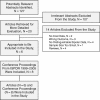Economic outcomes associated with atypical antipsychotics in bipolar disorder: a systematic review
- PMID: 18185820
- PMCID: PMC2139929
- DOI: 10.4088/pcc.v09n0603
Economic outcomes associated with atypical antipsychotics in bipolar disorder: a systematic review
Abstract
Objective: Bipolar disorder is a serious condition that is costly to the health care system. Atypical antipsychotics are more expensive than conventional treatments. From a policy-making perspective, the additional cost must be justified by improved outcomes. The objective of this study was to conduct a systematic review to determine the relative costs and cost-effectiveness associated with atypical antipsychotics in bipolar disorder.
Data sources: We conducted a systematic review of the literature in PubMed and EMBASE from January 1985 through October 2005, including published studies and conference proceedings. Databases were searched using predefined terms.
Study selection: Studies were included if they were claims data analyses, trial-based economic evaluations, or cost-effectiveness analyses using models. Data were extracted using predefined tables.
Data synthesis: Fourteen studies were identified. Seven were medical claims database analyses, 4 were trial-based economic evaluations, and 3 were cost-effectiveness models. Eight of these studies were conference proceedings. The studies did not provide sufficient information to determine any ranking of interventions in terms of least to most costly in overall resource consumption or in terms of their relative cost-effectiveness. Where comparable, results tended to be inconsistent.
Conclusion: There is a scarcity of economic studies in this field. A reference case outlining how to address the complex interplay between effectiveness, safety, adherence, and quality of life and their impact on resource use and costs is needed to contribute to improving the treatment of patients with bipolar disorder while making the best use of scarce health resources.
Figures
Similar articles
-
Economics of atypical antipsychotics in bipolar disorder: a review of the literature.CNS Drugs. 2006;20(7):591-9. doi: 10.2165/00023210-200620070-00004. CNS Drugs. 2006. PMID: 16800717 Review.
-
Generalisability in economic evaluation studies in healthcare: a review and case studies.Health Technol Assess. 2004 Dec;8(49):iii-iv, 1-192. doi: 10.3310/hta8490. Health Technol Assess. 2004. PMID: 15544708 Review.
-
Systematic reviews of the effectiveness of day care for people with severe mental disorders: (1) acute day hospital versus admission; (2) vocational rehabilitation; (3) day hospital versus outpatient care.Health Technol Assess. 2001;5(21):1-75. doi: 10.3310/hta5210. Health Technol Assess. 2001. PMID: 11532238 Review.
-
The Effectiveness of Integrated Care Pathways for Adults and Children in Health Care Settings: A Systematic Review.JBI Libr Syst Rev. 2009;7(3):80-129. doi: 10.11124/01938924-200907030-00001. JBI Libr Syst Rev. 2009. PMID: 27820426
-
Cost Effectiveness of Dialysis Modalities: A Systematic Review of Economic Evaluations.Appl Health Econ Health Policy. 2019 Jun;17(3):315-330. doi: 10.1007/s40258-018-00455-2. Appl Health Econ Health Policy. 2019. PMID: 30714086
Cited by
-
Cost effectiveness of adjunctive quetiapine fumarate extended-release tablets with mood stabilizers in the maintenance treatment of bipolar I disorder.Pharmacoeconomics. 2010;28(9):751-64. doi: 10.2165/11538350-000000000-00000. Pharmacoeconomics. 2010. PMID: 20623994
-
Combination Regimen With Lithium and Antipsychotic in Bipolar Manic Episodes: Impact on Adult Hospitalization Length of Stay.Cureus. 2020 Jun 11;12(6):e8568. doi: 10.7759/cureus.8568. Cureus. 2020. PMID: 32670704 Free PMC article.
-
Health care resource utilization and direct medical costs for patients with schizophrenia initiating treatment with atypical versus typical antipsychotics in Tianjin, China.BMC Health Serv Res. 2015 Apr 9;15:149. doi: 10.1186/s12913-015-0819-y. BMC Health Serv Res. 2015. PMID: 25880803 Free PMC article.
References
-
- Dean BB, Gerner D, Gerner RH. A systematic review evaluating health-related quality of life, work impairment, and healthcare costs and utilization in bipolar disorder. Curr Med Res Opin. 2004;20:139–154. - PubMed
-
- Leidy NK, Palmer C, and Murray M. et al. Health-related quality of life assessment in euthymic and depressed patients with bipolar disorder: psychometric performance of four self-report measures. J Affect Disord. 1998 48:207–214. - PubMed
-
- Hirschfeld RM, Vornik LA. Bipolar disorder—costs and comorbidity. Am J Manag Care. 2005;11:S85–S90. - PubMed
LinkOut - more resources
Full Text Sources

